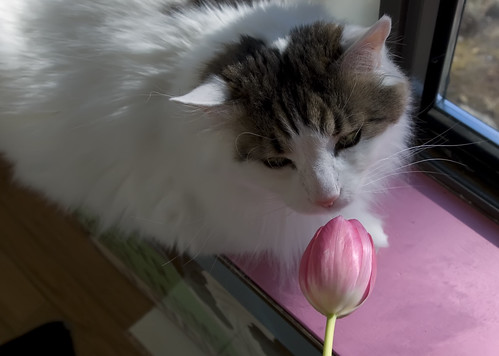
You are here
Save Your Cat's Life with a Simple Test
Spencer's had a breathing problem since I took him in as a foster six years ago.
During those years, I've taken him to both my Vet and specialists. Spent thousands of dollars hoping to find a way to keep Spencer happy and healthy. Sadly, I've had the following done to him:
• Tested for FeLuk, FIV, Diabetes (he went into ketoacidosis shortly after I got him) • Blood tests to determine allergies, then treated for ONE YEAR with hypo sensitization (shots) therapy because they thought his allergies were causing the wheezing • Treated with a nebulizer for asthma • Had a CT scan and visual exploration of his sinuses and palette • Diet change many times • Treated with allergy meds • Small course of steroids • Antibiotics up the ying-yang
NOTHING WORKED.
Then, I was told Spencer probably had scar tissue built up on his right sinus that was from and old upper respiratory infection and that he would just wheeze for the rest of his life, probably be sickly and that that was the best they could do.
Until two days ago.
Spencer's blood work has been showing some anomalies. First, his thyroid was off, then his BUN (BLOOD UREA NITROGEN (BUN) - This is a protein metabolite excreted by the kidney (it is one of the toxins we are concerned about). In a normal animal, the BUN is 25 or so. A good goal for BUN in kidney failure is 60-80. Often at the time of diagnosis, BUN is well over 150, 200, or even 300.) was high. My Vet took a look at Spencer's mouth and his gums were really AWFUL and breath was vile. Suddenly a bell went off in Dr. Larry's head. I could see it on his face.
"Have we tested Spence for Bartonella? This cat is presenting as though he has it."
Sure enough, a week later, the tests come back +3 positive for Bartonella, the dreaded Cat Scratch Fever. In a few days, the azithromycin will be here and I'll start Spencer on a 3 week course. It may completely change his life.
COMPLETELY CHANGE HIS LIFE!!!
After a lifetime of wheezing, now with inflamed gums, bad breath and signs of renal disease, Spencer may finally be on the road to a clean bill of health!
I want you to get out there and have your cats tested for Bartonella. The test is called: FeBart® Test and it's run by The National Veterinary Laboratory in Franklin Lakes, NJ. Yes, I'm plugging something for free. It's THAT important.
Why test?
Even if your cat stays indoors, 20% or MORE of indoor cats are infected for their entire life and can show no signs or symptoms for other diseases that mask that the true cause is Bartonella. Shelters, rescue groups don't routinely test for Bartonella. Strays, exposed to fleas and cats that live in warm climates prone to excessive flea infestation also have a high risk of carrying Bartonella, too.
The good news is that if your cat has the following problems, testing, then treating Bartonella can rid the cat of the related health issues!
Does your cat have:
Oral Disease: Gingivitis Stomatitis Oral Ulcers Submandibular lymphadenopathy Respiratory Diseases: URI Rhinitis Sinusitis Ocular Disease: Uveitis Chorioretinitis Conjunctivitis Intestinal Diseases: Inflammatory bowel disease Diarrhea (chronic) Vomiting (chronic) Skin Diseases: Dermatitis Papules- “acne” Granulomas Other Diseases: Lymphadenopathy Fever of unknown origin Liver Diseases Heart Diseases
Also, if your cat has Diabetes and is Bartonella positive, they can potentially significantly reduce their need for insulin!!!
(from The National Veterinary Laboratory)
"It has come to our attention, through the very astute observations of Dr. Phillip Raclyn of the Riverside Veterinary Group, New York, NY and Yorktown Animal Hospital, Yorktown Heights, NY, that azithromycin therapy of Bartonella infected cats with diabetes mellitus may markedly alter the requirement for insulin maintenance. Dr. Raclyn has treated two Bartonella-infected diabetic cats (treated for other Bartonella-associated diseases) with 21 days of azithromycin and noted that one cat no longer required insulin to maintain a normal blood glucose level. The second cat went into a hypoglycemic coma while being treated with azithromycin. The cat recovered and presently requires significantly less insulin for blood glucose maintenance.
We theorize that Bartonella may be responsible for inducing inflammation of the pancreas in some cats resulting in diabetes mellitus. Thus, when azithromycin therapy removes the Bartonella-infection, and resulting pancreatic inflammation, the insulin controlled glucose metabolism can return to normal in some cats. In this regard we have checked our Bartonella FeBart® Test records and found that 63 of 123 (51%) cats with diabetes were infected. Most of these diabetic cats were being tested for another reason, such as gingivitis, URI or another Bartonella-associated inflammatory disease.
...
RECOMMENDATION
The blood glucose levels of Bartonella-infected diabetic cats, who are being maintained on insulin, should be monitored closely during azithromycin therapy. Alteration of the insulin maintenance dose may be required."
Bartonella infections also effect humans and dogs! If you'd like to know more, you can visit NVL's web site and please talk to your Vet, too!
Now go. Take good care of your cats and get them tested!
(and let me know how they're doing!)



















Comments
Poor Spencer
Great thing Spencer has such a good mama!
Nice to find you alive and well if this is the Robin Olson that I remember from years past... back in the old and early Mac days...
Hope all is well and that you're as happy as you deserve - congrats on getting hitched! He looks kinda familiar....
If you aren't the Robin I used to know - great website and again, congrats on getting married!
:)
Take care -
Chuck Carter
!!!
As I live and breathe! And I just got home from a Drupal conference in Boston! Do things really change much?
Yes, it's the same Robin you remember from years past! What in the world brings you to my humble web site? I'm glad you stopped by and hope you're doing well. Drop me a line some time and we can catch up!
You can reach me via info@coveredincathair.com
Thank you for visiting!
:-)
Robin, Your Catastic Hostess
-Covered in Cat Hair
Less people know about it
Ted Nugent made Cat Scratch Fever (actually called “Cat Scratch Disease”) nearly a household name by advertising with his song but most people still know very little about this infection other than it involves a fever spread by cat scratches. In fact, it involves infection by a bacterium called “Bartonella henselae” which is spread by fleas. Classically, cats transmit the organism when they are parasitized by fleas, scratch themselves, and get infected flea dirt (digested host’s blood excreted by fleas) in their claws, and scratch a person (or another cat) with their dirty claws. Cats can also harbor Bartonella in their mouths and transmit the infection via bites or groom their feet and self-infect their claws.
All Good Points
That's why I'm sharing info I learn about Bartonella here on CiCH. Out of seven cats-THREE of my cats were positive for Bartonella. None of them do more than go out on a deck. None of them are related or bite/scratch the others. Bartonella may be the cause of many health issues in cats and I hope that more and more people test for it as it can go undiagnosed for YEARS.
Thanks for your post!
Add new comment